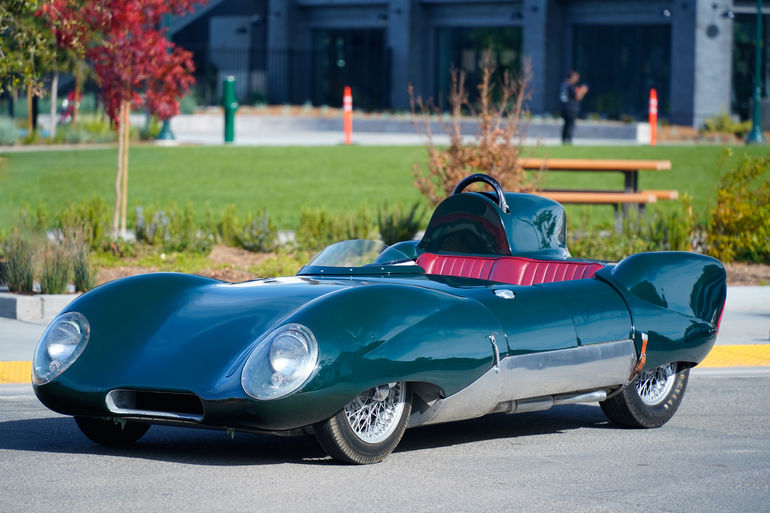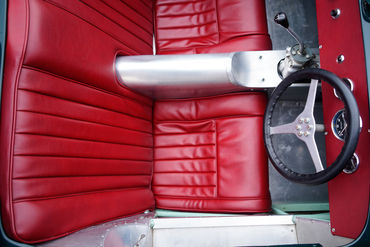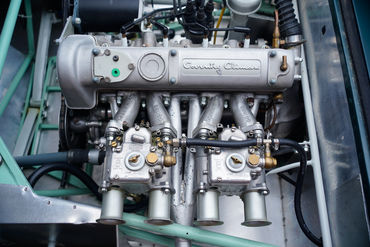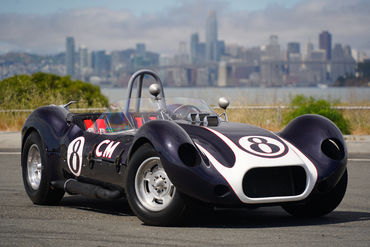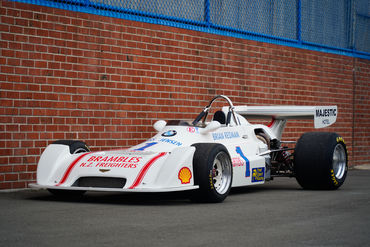Sold
SOLD 12/23
1956 Lotus
11
Bring A Trailer No Reserve Auction Preview: Maybe one of the prettiest 1950's sports cars, upgraded to FWE 1216cc Conventry Climax engine, Road&Track test car
- VINMK11 234
- Exterior ColorGreen
- Interior ColorRed leather
- MileageTMU
- EngineCoventry Climax FWE 1216cc inline 4-cylinder
- Transmission4-speed manual
- StatusSold
- StockFJ2808
Description
1956 Lotus Eleven
Chassis No. – MK11 234
Exterior Color – British Racing Green
Interior Color – Red
Engine – Coventry Climax 1216cc inline four-cylinder
Transmission – 4-speed manual
Current Miles – TMU
History of Lotus Eleven
As one of the earliest and most important cars in establishing the Lotus lineage, the Lotus Eleven was a remarkable achievement for the then upstart offering in the sports racing arena. Engineered by Colin Chapman with a beautiful aerodynamic body designed by Frank Costin, the Coventry Climax FWA front mounted engine nestled at an angle inside the lightweight tubular steel frame, utilizing a De Dion tube rear axle and Girling brakes. Remarkably, the entire car weighed just under 1,000 lbs. and proved to be a heady competitor, placing 7th overall in the 1956 24 Hours of Le Mans.
Though many engine options were utilized, and some cars were fitted with rear head fairings and a few with smaller rear fender fins, the basic formula for lightweight and superb handling made the Eleven a significant contender. In 1957, a 750cc powered Eleven won the Index of Performance at Le Mans, class victories accumulated in Sebring and Le Mans, and Sir Sterling Moss would set a class record in a bubble topped Eleven turning 143 mph at Monza. Top name drivers like Innes Ireland, Mike Hawthorne, and Graham Hill also drove the Eleven to world class victories.
With a total of just 270 built from 1956-1958, these cars continue to be highly sought after by sportscar and vintage racing enthusiasts eager to enjoy the many benefits of these legendary hand-built cars.
History of this Lotus 11
Having formerly emerged from a collection in California, this Lotus Eleven was the subject of a restoration completed some years ago and subsequently upgraded to “Club” specifications with the addition of a Coventry Climax FWE-400 1261 cc engine. This FWE engine while greatly improving performance without significant increase to the overall weight of the car, has a very interesting history as noted here. The September 1957 article in Road & Track features what is believed by Lotus historians to be this car, #234. At the time of testing, #234 had a small displacement Ford engine installed. This car is known to have been the only Ford 1172 powered Lotus Eleven officially imported to the states by USA Lotus distributor, Jay Chamberlain, Burbank, CA.
In 2016, the current owner purchased this car and worked with Lotus experts to understand the detailed build and construction elements of the body and chassis. Importantly, the Lotus chassis plate, numbered MK II 234 is identified as an authentic Lotus chassis plate, affixed with rivets, and corresponding directly to a prior Pennsylvania State Title (included with the car) bearing the same number.
As is the case with many race cars of this era, the chassis shows evidence of former repair work including replacement tube segments of newer construction. Both the steel sections and welds conform to original specifications and dimensions. Though accurate in construction, dimensions, and details, and some component brackets are of original construction, the chassis is reflective of both factory and post-factory build features. These observed conditions have been noted by one expert suggesting that the entire frame might be of new construction. As is very often the case with tube frame race cars of this era, it’s possible these components, portions, or sections may have been replaced for safety and reliability or fortified for the sake of preservation. However, several frame sections retain former mounting holes, weld marks, and characteristics consistent with original tubing. Details such as the battery box, spare tire support tubes, and the forward upper cross tube are examples of both original and post-factory construction. Other observations include four correct, unstamped original knock offs, new electrical wiring, and a modified parking brake system.
The tub panels appear to have been fabricated more recently including the rear floor pan, which is correct, though measuring slightly thinner material thickness than original specifications. The main body panels are consistent with original construction but have been modified in smaller areas to allow for fitting to the chassis. The bonnet bears all the signs of original construction, as does the cowl, windscreen, and some portions of the tail section (though records indicate that #234 was not originally configured with a head fairing). Overall, it appears that this car was restored to Club specifications possibly in the 1990s. The restoration appears to have been performed to a very high standard with attention to accuracy performed on the chassis and tub construction while retaining the original alloy body panels.
Current Condition
Today this rare Lotus Eleven presents with a balanced combination of mechanical care and cosmetic presentation. The Lotus Eleven exemplifies the lightweight materials and engineering that would become the cornerstone of the Lotus build philosophy to “add lightness”. The mechanical vision, wide stance, and low profile while difficult to convey in photos, create a truly unique car from every view. The historic British Racing Green finish, Costin profile, wire wheels, and competition wheelbase convey everything that Lotus would become famous for in years to come. The finish is glossy throughout, and the body panels show generally good fit, consistent with build quality of the era. The condition of the paint is consistent with mid-level cosmetics, though some areas show signs of age including scuff marks on the hood, minor body panel creasing and dimples on the right front fender, selected chips in the paint, some chipped and slightly deformed alloy at the fitting section around the roll bar, and slightly irregular fit on one corner of the driver’s side door.
A set of period correct wire wheels are mounted featuring double-ear knockoffs, vented drum brakes, and period correct Goodyear Blue Streak tires, which we would recommend replacing before spirited driving. The front and rear wheels are concealed under the Costin aerodynamic fenders contributing to the elegant and wind-cheating surfaces. Taillight lenses, headlight covers, and spring-loaded bonnet latches are all in good to very good condition. Other exterior details include a polished alloy fuel filler cap, leather front and rear bonnet straps, and the distinctive head fairing. In all, the alloy body exterior presentation is quite nice for someone who wishes to drive an historically important car featuring durable and serviceable mechanicals and satisfying cosmetics.
The interior, while sparse and purposeful, displays nicely tailored vinyl trim over alloy panels properly positioned in traditional left hand drive configuration. The seats have ample foam cushion and correct style pleating design. Although there are no seatbelts fitted, it is possible to utilize anchor points affixed to the chassis and roll bar. Most notably, the red panel dashboard features a Smiths tachometer, with supporting oil, water, and amp gauges. The left-side shifting 4-speed gear selector sits readily at hand surrounded by raw alloy panels and contrasting red interior. A padded steering wheel, curved windscreen, and swing-out doors complete the competition aesthetic.
Underneath the lightweight removable alloy rear deck lid, the engineering simplicity is almost surprising. The battery is located at the rear featuring a solid rear axle and coil over suspension all of which are readily accessible for service or repairs. The forward opening bonnet layout allows for easy access to the angled overhead cam Coventry Climax engine, fitted with twin Weber 40 DCOE2 dual throat carburetors, a Derrington CC1100 intake manifold, tube header exhaust, generator, and various systems. The engine compartment is professionally prepared to excellent cosmetic standards using authentic components and correct finishes. The mechanical features are consistent with a high level of finish, properly maintained since the restoration was performed. The underside of the car is clean and indicative of minimal miles under current ownership. There is no visual evidence of structural damage to the floor pan or chassis.
The car starts and runs very well, generating great exhaust sounds at idle or when blipping the throttle. Steering response is quick and very direct with a light feel consistent with the competition lineage of these cars. The gearbox operates properly with smooth clutch engagement and brisk acceleration, with just a bit more response due to the Club spec. engine. The overall driving experience is invigorating and engaging even when driving at moderate city speeds. Although this car is complete and drivable, a major winter service is recommended before any spirited driving, on road or track, which should also include a new set of tires.
Included with this Car
This Lotus Eleven comes with a copy of the 2016 inspection report, two 1957 Road & Track magazines (articles on the Lotus Eleven included), and two different size pairs of modern air cleaner elements.
Please note that this car is in inventory and on transferable title; however, depending on your state of residence, registration for street use is not guaranteed due to variations in state requirements.
The above vehicle information is complete and accurate to the best of our knowledge at the time it is posted to this website. Corrections or additional information is always appreciated. All advertised prices exclude government fees and taxes, any finance charges, any dealer document preparation charge, and any emission testing charge. Vehicles are subject to prior sale. All advertised to be true but not guaranteed. We assume no liability for errors or omissions.
Inquire About This Car
Fantasy Junction • 510-653-7555 • 1145 Park Ave, Emeryville, CA 94608
